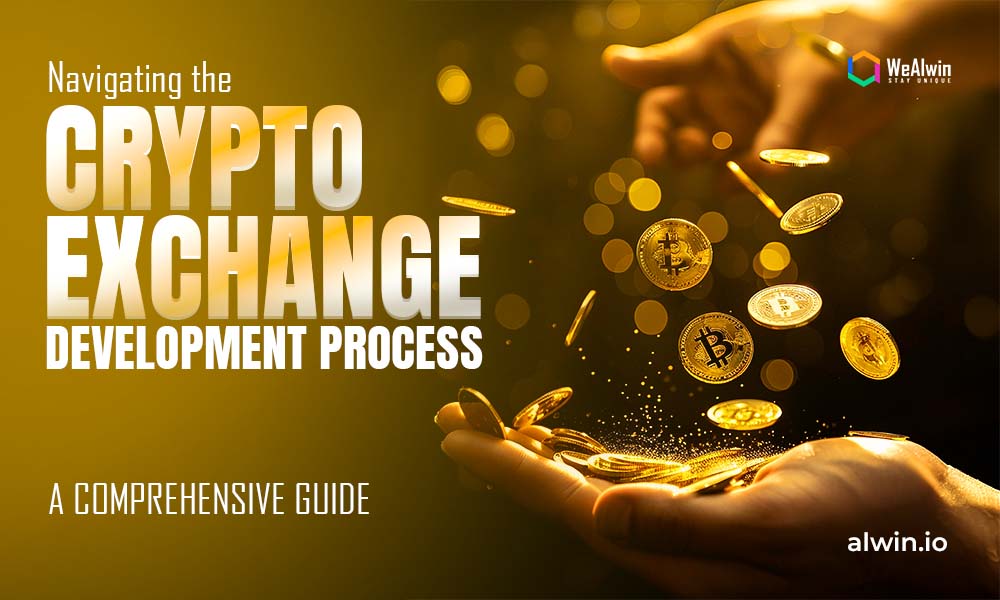Crypto exchange platforms are the backbone of the cryptocurrency market, influencing everything from market liquidity to price stability. These platforms facilitate billions of dollars in transactions each day, making them central to the buying, selling, and trading of digital currencies. The volume of trades on these exchanges directly impacts the stability and valuation of cryptocurrencies, underscoring their critical role in the financial ecosystem.
Given this importance, businesses are increasingly drawn to developing their cryptocurrency exchanges. This growing interest is fueled by the potential for significant market opportunities and the desire to provide a robust, secure platform for trading digital assets. Whether it's a centralized exchange (CEX) known for its liquidity and user-friendly interface or a decentralized exchange (DEX) offering enhanced privacy and user control, each type serves a unique purpose within the market.
This blog will provide an in-depth look at the crypto exchange development process, offering valuable insights into building a successful exchange that meets market demands and ensures security and reliability.
What Is Cryptocurrency Exchange Development?
Cryptocurrency exchange development basically means building an online platform where people can trade digital currencies in a safe and simple way. At its core, it’s about creating a space that feels dependable, something that loads quickly, looks clean, and doesn’t confuse users the moment they land on the screen.
When a business starts developing a crypto exchange, the goal is to create a system that feels stable and trustworthy from the very beginning. This includes everything from the layout and navigation to how fast trades are processed. Real-time updates, easy-to-understand tools, and a design that doesn’t overwhelm new users all play a major role in shaping that experience.
A well-built exchange helps users feel comfortable, even if they’re not crypto experts. It also supports long-term growth for the business because people tend to stick with platforms that feel straightforward and honest. And of course, a clean structure and strong performance help the platform appear more reliable across search engines and digital channels.
Understanding the Crypto Exchange Development Process
Initial Planning and Research
Successful crypto exchange development begins with thorough initial planning and research. This foundational step is crucial for defining the scope and direction of your project.
Market Research and Understanding Target Users
Conducting comprehensive market research is essential to identify your target audience and understanding their needs. This includes analyzing market trends, competitor platforms, and user preferences. By gathering insights into what users seek in a crypto exchange—such as ease of use, specific trading features, or security concerns—you can tailor your platform to meet these demands effectively.
Setting Clear Business Goals
Establishing clear and actionable business goals is another key aspect of initial planning. Determine what you want to achieve with your crypto exchange, whether it's capturing a specific market share, offering innovative trading features, or establishing a niche in the market. These goals will guide your development process and help measure your platform's success.
Legal and Regulatory Requirements
Navigating the legal and regulatory landscape is crucial for the success of your blockchain exchange development. Different regions have varying regulations concerning cryptocurrency trading, including Anti-Money Laundering (AML) and Know Your Customer (KYC) requirements. Ensuring compliance with these regulations is essential to avoid legal issues and build trust with your users.
Choosing the Right Technology Stack
Selecting the right technology stack is crucial for a successful crypto exchange. Key technologies include Node.js, React, Next.js, MongoDB, Express.js, Flutter, and React Native. These tools ensure your platform is scalable, secure, and user-friendly, providing a seamless experience for traders across all devices.
Cost Of Developing a Crypto Exchange
The development of a crypto exchange involves various cost factors, each contributing to the overall budget. Understanding these cost drivers helps in planning and managing your project effectively.

Examples of Cost Variations
Simple Exchange: A basic exchange with essential trading features, minimal customization, and standard security measures might cost between $50,000 and $100,000. This estimate typically includes development and initial compliance costs.
Advanced Exchange: A more complex platform with advanced features, high-end security, and extensive customization could range from $150,000 to $500,000 or more. The costs here include extensive development work, advanced technology integration, and comprehensive regulatory compliance.
Enterprise-Level Exchange: For large-scale exchanges with extensive features, high scalability, and cutting-edge security measures, the costs can exceed $500,000. This category often involves prolonged development periods and significant investment in technology and compliance.
Timeline for Developing Crypto Exchange
Estimating the timeline for crypto exchange development involves understanding the typical stages and factors that can influence the duration of each phase.
Typical Timeline for Development
Planning and Research (1-2 Months): This initial phase includes market research, setting business goals, and outlining the project scope. This period is essential for defining requirements and creating a roadmap.
Design and Prototyping (2-3 Months): During this phase, the platform’s user interface (UI) and user experience (UX) designs are developed. Prototyping helps in visualizing the end product and refining the design based on feedback.
Development (4-6 Months): The core development phase involves coding, integrating features, and building the trading engine. The duration can vary depending on the complexity of features and technology stack used.
Testing and QA (2-3 Months): Rigorous testing is conducted to ensure the platform’s functionality, security, and performance meet the required standards. This phase involves bug fixing and optimization.
Deployment and Launch (1 Month): The final phase includes deploying the exchange to a live environment, conducting final checks, and launching the platform to users.
Factors Influencing the Timeline
Technology Choices: The choice of technology stack and development tools can impact the development speed. Advanced technologies may require more time for integration and customization.
Regulatory Hurdles: Navigating legal and regulatory requirements can affect the timeline. Compliance checks and obtaining necessary licenses may introduce delays.
Feature Complexity: The complexity of features and customization requirements can extend the development time. More sophisticated features and integrations generally require additional time for development and testing.
Core Features of a Successful Crypto Exchange
A successful crypto exchange relies on several core features that ensure its functionality, security, and user satisfaction.
1. Trading Engine: The trading engine is the heart of any crypto exchange, responsible for executing buy and sell orders. It handles order matching, and trade execution, and manages the order book. An efficient trading engine ensures quick and accurate transactions, which is crucial for maintaining liquidity and user satisfaction.
2. User Wallets: Secure user wallets are essential for storing and managing cryptocurrencies. Crypto exchanges typically offer both hot wallets (online) for active trading and cold wallets (offline) for long-term storage. Implementing robust wallet management systems helps protect user assets from theft and hacking attempts.
3. Order Matching System: The order matching system facilitates the matching of buy and sell orders on the exchange. It ensures that transactions are processed efficiently and fairly, with minimal delay. A well-designed order-matching system contributes to a smooth trading experience and helps maintain market stability.
4. Advanced Security Features: Security is paramount in crypto exchange development due to the high value of digital assets. Key security features include,
- Two-Factor Authentication (2FA): Adds an extra layer of protection by requiring users to provide a second form of verification beyond their password.
- KYC/AML Compliance: Know Your Customer (KYC) and Anti-Money Laundering (AML) processes are essential for verifying user identities and preventing illicit activities.
- Encryption: Encrypts data both in transit and at rest, protecting sensitive information from unauthorized access and ensuring data integrity.
5. Margin Trading: Margin trading allows users to borrow funds to increase their trading positions. This feature can attract experienced traders looking for leverage to maximize their profits. Implementing margin trading requires careful management of risks and robust risk mitigation strategies.
6. Staking: Staking features enable users to earn rewards by participating in the network's operations, such as validating transactions. This can incentivize users to hold and stake their cryptocurrencies on your platform, creating additional engagement and liquidity.
7. Multi-Currency Support: Supporting a wide range of cryptocurrencies can differentiate your exchange from competitors. Offering diverse trading pairs and integrating popular digital assets increases the platform's appeal to a broader audience.
Security Measures In Our Cryptocurrency Exchange
In the world of cryptocurrency, security is not just an option—it's a necessity. Protecting user data and assets is paramount to maintaining trust and ensuring the long-term success of a crypto exchange.
1. Security Protocols:
- Encryption: Encrypting data both in transit and at rest ensures that sensitive information is protected from unauthorized access. Implementing advanced encryption protocols, such as AES-256, helps secure user data and transaction details.
- Two-Factor Authentication (2FA): Adding an extra layer of security, 2FA requires users to provide a second form of verification beyond their password. This could be a code sent to their mobile device or generated by an authentication app.
- Cold and Hot Wallets: Using cold wallets (offline storage) for the majority of user funds and hot wallets (online storage) for active trading balances can help mitigate the risk of theft. Cold wallets are less vulnerable to cyber-attacks compared to hot wallets.
- Multi-Signature Wallets: Multi-signature wallets require multiple private keys to authorize transactions, adding an extra layer of security. This reduces the risk of unauthorized transactions and enhances overall security.
2. Common Threats and Preventive Measures:
- Hacking: Cyber-attacks targeting crypto exchanges are a common threat. To counter this, implement robust network security measures, including firewalls, intrusion detection systems (IDS), and regular vulnerability assessments.
- Phishing: Phishing attacks attempt to trick users into revealing their login credentials. Educate users about phishing risks and implement email and website security measures to detect and prevent phishing attempts.
- DDoS Attacks: Distributed Denial of Service (DDoS) attacks can overwhelm the exchange's servers, causing downtime. Use DDoS protection services and load balancers to mitigate the impact of such attacks.
Choosing the Right Cryptocurrency Exchange Development Company
Selecting the right development partner is crucial for a successful crypto exchange project. Key criteria include:
Experience and Expertise: Look for a company with extensive experience in crypto exchange development. Review their portfolio to assess their ability to deliver high-quality solutions.
Technical Proficiency: Ensure the company has a deep understanding of blockchain technology and the specific requirements of crypto trading platforms. Their technical skills should align with your project needs.
As the crypto landscape evolves, staying ahead of trends is crucial for success:
Decentralized Exchanges (DEXs): The rise of DEXs reflects the growing demand for user-controlled, secure trading platforms. Integrating decentralized features can enhance security and user trust.
DeFi Integration: Incorporating DeFi functionalities like yield farming and lending into exchanges is becoming popular. This not only attracts more users but also increases platform utility.
AI-Driven Tools: AI and machine learning are increasingly being used for predictive analytics, trading bots, and enhanced user experiences. Leveraging these tools can give your exchange a competitive edge.
Future-Proofing: Adopting these emerging technologies and trends early on will help ensure the longevity and relevance of your crypto exchange.
Summary of the Crypto Exchange Development Process
Developing a successful crypto exchange involves careful planning, selecting the right technology, ensuring robust security, and staying compliant with regulations. From initial research to post-launch maintenance, each step is crucial for creating a platform that meets market demands and user expectations.
As the cryptocurrency market continues to evolve, now is the time to take action. Whether you're ready to start your development journey or need expert guidance, the right partner can make all the difference.
Why Choose WeAlwin for Your Cryptocurrency Exchange Development?
Choosing WeAlwin as your trusted cryptocurrency exchange development company gives you a clear and assured path to build a secure, stable, and user-ready platform powered by strong blockchain expertise. Every step is supported with open communication, practical guidance, and genuine dedication to your progress, making the journey smooth and purposeful. Their team delivers clean development, smart architecture, and long-term value, helping your Crypto exchange platform stand strong in a fast-evolving market.
If you’re ready to launch with clarity and strength, connect with WeAlwin and begin your successful crypto exchange journey today.



